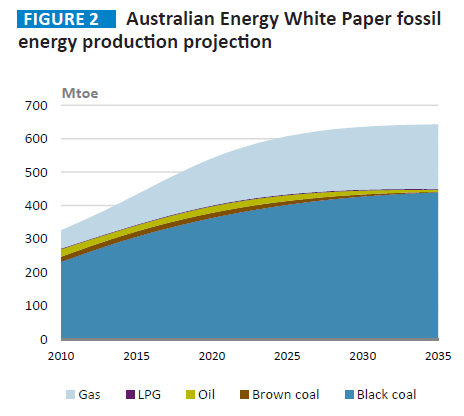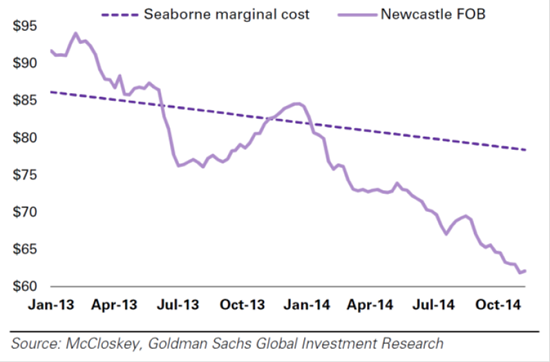In Climate clippings 115 I cited an article from The Conversation which suggested that Australia’s coal and gas exports are being left stranded.
Just four countries account for 80% of Australia’s fossil fuel exports – China, Japan, Korea and India.
China is on the verge of “peak coal”, rebalancing the economy away from energy intensive industry and introducing a national emissions trading scheme.
Japan is on an energy efficiency drive to reduce its fuel import bill.
Korea has introduced a tax on coal of AU$18 per tonne and is finalising an emissions trading scheme.
India has doubled its tax on coal which funds renewable energy projects and has signalled its intention to stop importing coal within 2-3 years.
Yet the Queensland Government has signed off on a $16 billion development of a huge Galilee Basin mine and is prepared to chip in with a few hundred million to enable the infrastructure to be built.
Premier Campbell Newman said that “the State Government would work with resource companies to make strategic investments that could create up to 28,000 new Queensland jobs.”
At the same time the Queensland Government has introduced water reform legislation which seems squarely targeted at providing unlimited water to the Galilee Basin mining operation. This is being done in a reckless manner at the possible expense of graziers and towns in the area. Indeed careless disregard is being shown for the integrity of the Great Artesian Basin itself.
Tristan Edis at Climate Spectator has taken a look at the folly of official of the official Bureau of Resource and Energy Economics forecasts on fossil fuel energy production. Edis looks at the Australian Energy White Paper, a paper from BZE (Beyond Zero Emissions) entitled A fossil economy in a changing world and the IEA World Energy Outlook 2014. I recommend reading Edis’s article in full but two graphs tell much of the story. First the Australian Energy White Paper fossil energy production projection:

That is the glorious future envisioned by our Tea Party governments in Canberra and Brisbane. Here they are being mugged by reality. The dotted line represents the improved cost of coal production. The continuous line represents the price trajectory:

I would just point out that the author of the BZE report and the article from The Conversation linked at the top of the post is Stephen Bygrave, who is CEO of Beyond Zero Emissions and Adjunct Professor in the Faculty of Science at UNSW Australia.
Finally John Quiggin at The Conversation takes a look at the economic case for fossil fuel divestment. As he says at his blog, the bottom line is:
Leaving aside the ethics of divestment and pursuing a purely rational economic analysis, the cold hard numbers of putting money into fossil fuels don’t look good.
Unless universities are willing to bet on the destruction of the planet they have committed themselves to understanding and preserving, divestment from fossil fuels is the only choice they can make. Forward-thinking investors of all kinds would be wise to follow suit.
In blunt terms we are dealing with stranded assets here. Beyond that Abbott, Newman and their acolytes should be arrested for treason. Or something!
I’m wondering too whether Clive Palmer’s Galilee Basin holdings will prick his financial bubble.


Whilst nicely enunciated, with respect Brian, the outlook for the Galilee Basin (and coal generally) is not really new news.
Nor is the appalling environmental policies of the Abbott and Newman governments.
I keep asking myself, “How can they remain so obstinate and hold to their destructive policies so determinedly?” How can anyone, in the face of a tsunami of research and powerful intellects maintain a stoney defiance of these generational matters? Not even an attempt to explain how an economic enterprise is more important than anything else. Especially given the more recent drop in coal, iron ore and oil prices.
I have thought the logical answer might be a simple cash pay-off to Party, personal or both. But if that is true, facts seem to be well hidden no one seems to have evidence of that except in NSW. Maybe there is a crap-sheet on these guys and it is kept secret as long as they tow the line? Or could it be just iceberg-size ego? Abbott’s residual priestly ambitions, Newman’s born-to-rule mind?
I don’t know what could be more important for a leader than looking ahead and planning a secure future – even for their own grand children.
If someone could explain to me what are the drivers of this absurd denialist policy I would be very appreciative. I’m not looking for an adverse reflection of Abbott’s or Newman’s chastity and parentage, just some insight into what powerful forces underpin the freaky denialism we are living with.
Geoff, I think there is a basic climate denialism there on the part of both Abbott and Newman. Climate is something you do because the electorate demands it. Newman does nothing seeing it as a Federal issue. In addition Peabody has been promoting the notion that coal is the answer to the extensive need for billions of poor who don’t have access to grid electricity. Hence coal is good for humanity.
None of then have any idea of the climate budget approach and think of climate mitigation can be done later if the science turns out to be valid.
Also they see climate mitigation as a program off to the side that you can do a bit on if you can afford it. They completely miss the need for the transformation of industry generally to low carbon forms of production.
Thanks Brian.
My own denial is that they just won’t “see” given the massive weight of evidence before them. That they are holding to a policy or division of responsibility between State and Federal is doubtless true, but in itself I can’t see that as sufficient reason.
I’m still in some (naive?) state of disbelief and trying to find some force majeure sustaining our elected leaders distorted policies. What is their rationale? That new coal is viable is under great doubt. Same for coal seam gas. Our climate is bleeding and our pollies are holding on to that which is wounding us.
Past experience says that mining is a cyclic industry where shortages drive prices up which in turn drives investment in new extra capacity. The extra capacity creates a surplus which drives prices down to the point where production is reduced and some mines shut down, often forever. Miners comfort themselves by taking about the cyclic nature of the industry during downturns.
Sometimes however, what we are looking at is not the simple cycle I was talking about above. For example, the long surge in in demand over recent years was driven by growth in the Chinese economy and the demand for steel and energy.
What is going along now with thermal coal is not simple either. China has decided that it needs to reduce emissions and that this can be done by reducing fossil fuel consumption.
At the same time India appears to have come to similar conclusions made even worse by a realization that it is easier to use localized renewable energy instead of spending enormous amounts setting up a grid to connect fossil fuel power stations to customers.